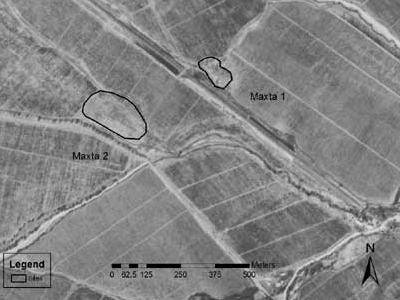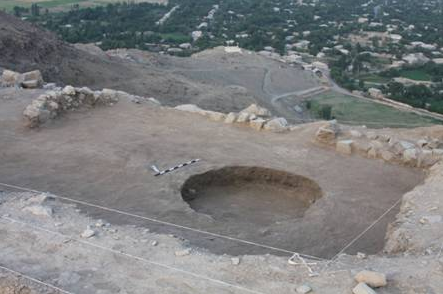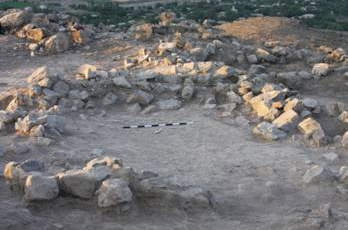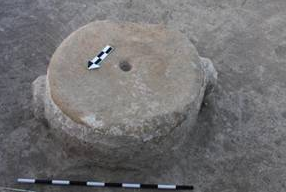The 2009 excavations focused on exposing a large horizontal area within the citadel—the palace located at the highest point of the mountain. We expanded the excavation trenches previously opened in 1988-1989 and 2008 and exposed levels dating to the Middle Iron Age (Oğlanqala IIIb), Late Iron Age (Oğlanqala IIIa), Classical Period (Oğlanqala II) and modern periods (Oğlanqala I) across more than 1200 m2 (14,000 sq. ft).
Surface survey and satellite imagery analysis indicate that a fortified area encompassing 1.2 ha defined the palace district (Figure 1). The area appears to be composed of at least two discrete buildings. The main palace, to the north, occupies 4000 m2. The area to the south, called the entrance area during our survey, appears to be another monumental building, constructed of the same Cyclopean blocks as the Southern wall of the main palace.
Period IIIb: Middle Iron Age
Probably in the beginning of the 8th century BC, the citadel area was terraced prior to the construction of the palace to create a larger and reasonably level surface on which to build (Figure 2). Walls were made of local limestone, probably quarried from Karatepe itself. The original walls of the fortress were built out of large, roughly-worked blocks, with a rubble core. The southern and eastern walls of the monumental courtyard were each between 2 and 2.5 m wide.
Much of the area exposed to date in the palace comprises a single room, a mounumental courtyard which encompasses 700 m2—or 7,500 sq feet (Figure 3). This courtyard is similar to those found in other 8th century palaces in the Caucasus and Turkey. It is about the same size as the columned hall at Erebuni, Armenia and a bit smaller than a similar room at Altintepe, Turkey.
The steep slopes of Oğlanqala and the massive stone architecture of the fortifications and the palace emphasize both the defensive character of this site and express a potent message of strength and power. The 8th century material from this fortress similarly underlines its military and administrative functions. A cache of 15 iron arrow-heads was found lying atop the concrete floor in the courtyard (Figure 4), while enormous coarse-ware storage jar sherds, some with cuneiform inscription were the most common form of pottery from the area.
Period IIIa-II: Late Iron Age
We do not know when the Middle Iron Age citadel was abandoned, or for how long, but it is clear that sometime in the middle of the fourth century, someone undertook a major reconstruction program here. Although work on the Late Iron Age palace was never finished, in 2009 we uncovered some intriguing evidence for this elusive phase. 29 column elements have been uncovered in the earlier Soviet and in the current Azerbaijani-American excavations in the Oğlanqala citadel. These include three bases, one capital, five "plinths" (or possibly unworked square blocks), and twenty drums. None of these architectural elements were "finished". The drums still had lifting bosses attached, chisel marks were visible on most of the pieces, and none of the elements had been smoothed and fluted.
The columns themselves, particularly the bases, resemble Achaemenid ones, especially those found at Susa, one of the imperial capitals (Figure 5). Yet complete stone columns are extremely unusual in the Achaemenid empire, outside of the capitals. Although many Achaemenid administrative sites, including several in the Caucasus had columned halls, the columns themselves were made out of wood or mudbrick and only the base was made of stone. Also associated with the column drums are several different kinds of pottery, with parallels from Achaemenid levels at sites in Iran and Armenia and sites beyond the Persian Empire in Georgia and Southern Russia (Figure 6).
A large number of pits are cut into the remains of the palace—sometimes disturbing Middle and Late Iron Age walls. These giant pits often contain large quantities of burnt sheep and cattle bones. Many of them date to the Late Iron Age, to Oglanqala periods IIIa and II. Some of them may be associated with the unfinished building—they could be trash pits deposited by the workers. Others appear to date to the later Parthian period. We have discovered no Parthian architecture yet at the citadel, but there are such constructions elsewhere on the site. During the late first millennium BC, this many have been an area where Oğlanqala's rulers held feasts, or it could have been an abandoned area where they processed animal remains.
Period I: WWI
Temporary structures, graves and large numbers of trash pits found in the citadel all date to 1919-1920, the end of fighting on the Caucasus front in WWI. Circular structures with stone foundations, perhaps the remains of temporary fortifications or tent foundations, have been recognized across much of the site (Figure 7). Along with large quantities of household equipment, including glass, porcelain, storage jars, buttons, etc., we found the remains of weaponry (Figure 8). It seems likely that the people who camped on Oğlanqala at the very end of WWI included both villagers fleeing from their homes in the valley, as well as resistance fighters.




